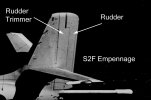Not to mention the concern over an engine-out situation. If I remember correctly, the first twin-engine aircraft to land on a U.S. aircraft carrier was the PBJ (B-25) that did trials in WW2. It was really only the North American AJ (due to the extremely high priority of getting nuclear capability to sea with the large bombs of the era) and the Grumman S2F (with its unique two-section rudder) that broke the opposition to twin-piston engine aircraft on carriers.Since we are on “unattractive” twins…here is the Grumman F5F Skyrocket.
View attachment 37893
It was in direct competition with the Wildcat, Corsair, Spitfire, Hurricane, Aerobonita (navy version of Aircobra), and Buffalo. She beat them all but the navy was concerned it would be too hard to maintain parts. Here is a test pilot report from the era…
“I remember testing the XF5F against the XF4U on climb to the 10,000 foot level. I pulled away from the Corsair so fast I thought he was having engine trouble. The F5F was a carrier pilot's dream, as opposite rotating propellers eliminated all torque and you had no large engine up front to look around to see the LSO (landing signal officer) ... The analysis of all the data definitely favored the F5F, and the Spitfire came in a distant second. ... ADM Towers told me that securing spare parts ... and other particulars which compounded the difficulty of building the twin-engine fighter, had ruled out the Skyrocket and that the Bureau had settled on the Wildcat for mass production."
Attachments
Last edited:

